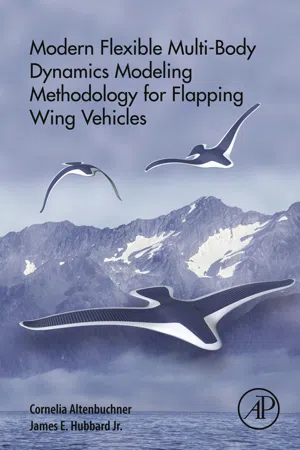
Modern Flexible Multi-Body Dynamics Modeling Methodology for Flapping Wing Vehicles
- 198 pages
- English
- ePUB (mobile friendly)
- Available on iOS & Android
Modern Flexible Multi-Body Dynamics Modeling Methodology for Flapping Wing Vehicles
About This Book
Modern Flexible Multi-Body Dynamics Modeling Methodology for Flapping Wing Vehicles presents research on the implementation of a flexible multi-body dynamic representation of a flapping wing ornithopter that considers aero-elasticity. This effort brings advances in the understanding of flapping wing flight physics and dynamics that ultimately leads to an improvement in the performance of such flight vehicles, thus reaching their high performance potential. In using this model, it is necessary to reduce body accelerations and forces of an ornithopter vehicle, as well as to improve the aerodynamic performance and enhance flight kinematics and forces which are the design optimization objectives.
This book is a useful reference for postgraduates in mechanical engineering and related areas, as well as researchers in the field of multibody dynamics.
- Uses Lagrange equations of motion in terms of a generalized coordinate vector of the rigid and flexible bodies in order to model the flexible multi-body system
- Provides flight verification data and flight physics of highly flexible ornithoptic vehicles
- Includes an online companion site with files/codes used in application examples
Frequently asked questions
Information
Bioinspired Flight Robotics Systems
Abstract
Keywords
1.1. Introduction of This Body of Work
1.2. The Background of Flapping Wing Flight Technology
1.2.1. Aerial Vehicles and Natural Flapping Wing Flyers

Table of contents
- Cover image
- Title page
- Table of Contents
- Copyright
- Dedication
- Preface
- List of Figures
- List of Tables
- List of Nomenclature
- Acknowledgments
- Summary
- Chapter One. Bioinspired Flight Robotics Systems
- Chapter Two. Flexible Multi-Body Dynamics Modeling Methodology's for Flapping Wing Vehicles
- Chapter Three. Bioinspired Flapping Wing Test Platform Used to Implement Modern Modeling Methodology
- Chapter Four. Flexible Multi-Body Dynamics Modeling Methodology Implementation Avian Scale Flapping Wing Flyer
- Chapter Five. Aerodynamics Modeling for Flexible Multi-Body Dynamics Modeling Methodology Implementation Avian Scale Flapping Wing Flyer
- Chapter Six. Results of the Modeling Methodology Implementation and Flight Simulation
- Chapter Seven. Concluding Remarks About Modern Modeling Methodology Implementation and Flight Physics of Avian Scale Flight Robotics Systems
- Index